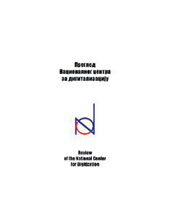Issues
Review of the National Center for Digitization
Publisher: Faculty of Mathematics, University of Belgrade
ISSN: 1820-0109
Issue: 37
Year: 2020

MEDIJI I DIGITALNE TEHNOLOGIJE: RADIO EMISIJA „DIGITALNE IKONE“
Tamara Vučenović
Keywords: mediji, radio, digitalizacija, digitalne tehnologije, Digitalne ikone, radio emisija.
Abstract
U ovom radu se opisuje medijski doprinos radio emisije Digitalne ikone, Radio Beograda 2 i
autorke Tamare Vučenović u predstavljanju, analizi i kritičkom promišljanju digitalnih tehnologija, procesa
digitalizacije i brojnih izazova sa kojima se suočavamo u tehnološki sve naprednijem okruženju. U radu je
ukazano na značajnu ulogu koju emisija „Digitalne ikone” ima u razvoju informacionog društva u Srbiji i
višegodišnjoj promociji i predstavljanju mogućnosti koje internet i nove tehnologije nude u pogledu
predstavljanja, očuvanja i negovanja naše tradicije, nauke i kulture.
1 - 6
MEDIA AND DIGITAL TECHNOLOGIES: THE RADIO SHOW "DIGITAL ICONS"
Tamara Vučenović
Keywords: Media, Radio, Digitization, Digital Technologies, Digital icons, Radio show.
Abstract
This paper presents and summarizes a media contribution of radio show Digital Icons, Radio
Belgrade 2 and author Tamara Vučenović to the representation, analyzing and critical thinking of digital
technologies, digitization processes and diverse challenges that we face in digitally growing surrounding. The
paper points out to important role of Digital Icons radio show in developing information society in Serbia and
continuous promotion and representation of the possibilities that internet and new technologies offer in terms
of presenting, preserving and nurturing of our tradition, science and culture.
7 - 12
TECHNICAL, ARCHITECTURAL AND INDUSTRIAL HERITAGE AT THE RAILWAY ŠID - DIMITROVGRAD
Zoran Cvetković and Ada Vlajić and Rifat Kulenović
Keywords: Serbian railways, railway history, railway infrastructure, industrial heritage, Orient Express.
Abstract
The Serbian railway Šid - Dimitrovgrad was completed at the end of the 19th century, and
besides occasional reconstructions and technological upgrades, it is still in service. The geographical
position of the railway route and the historical context at the time of construction and during operation,
made that the railway exceeded its local significance and become an important corridor of the European
railway network. In recent years, the strategic modernisation of the Serbian railway system, including the
Šid - Dimitrovgrad railway, is underway. That is why we have initiated the research of the industrial
heritage along the railway, which sometimes dates from the time of construction. Our purpose was to
identify, research and document existing railway installations and technical infrastructure, as well as the
industrial heritage surrounding the railway.In this article, we present the results of our research and
suggest ways to continuously preserve some of the valuable cultural, technical and industrial heritage.
13 - 27
CONTEMPORARY MODEL FOR THE DIGITIZATION OF ARCHIVAL RECORDS OF SCIENTIFIC INSTITUTIONS
Marija Šegan-Radonjić
Keywords: Digitization of cultural heritage, digital history, digital thematic collections, history of mathematics.
Abstract
The topic of thispaperis the development of a framework for digital archiving in order to
preserve, present and enable the availability of digitized and digital content for the purpose of historical
and other research. The proposed framework is based on the concept of “thematic collections̕ˮ and is
intended for researchers who want to create their own digital collections of historical sources and texts in
order to acquaint the wider scientific community with their research, connect them with a wider context
and create conditions for networking and cooperation. On the example of digitization of archival material
of the Mathematical Institute SANU,and in accordance with current recommendations and regulations
for digitization of cultural heritage in the Republic of Serbia, the proposed framework offers guidelines
for: 1) economical digital translation process to obtain operational copies for web presentation, 2)
cataloguing and description of digital documents using the Dublin Core set of elements, 3) creating a
digital archive using the Omeka Classic platform, 4) creating guidelines for archival research on specific
historical topics, and 5) compiling historical essays in a digital environment. The expected results are: 1)
proposal for a framework for digital archiving of digital and digitized content for the purpose of historical
and other research, and 2) digital collection dedicated to the history of mathematics and related sciences
in Serbia and Southeastern Europe.
28 - 45
ALGORITHM FOR DOCUMENT AUTHORSHIP IDENTIFICATION AND PLAGIARISM EVALUATION BASED ON GENERALIZED SUFFIX TREE
Aleksandar Veljković
Abstract
Identifying an author of an anonymous text document is an important problem when
dealing with historical data. As authors have their own characteristic writing styles, expressed through
specific phrases, sentence constructions or word choices, their text documents incorporate the style and create
implicit connection with the author. This paper proposes an approach for identification of authors of the
anonymous documents, based on generalized suffix tree data structure and defined similarity score, suitable
for analysis of digitized historical text documents. The following method can also be used for detecting and
evaluating plagiarism, where the document author is known, but the document shows a high similarity with
documents from another author.
46 - 51